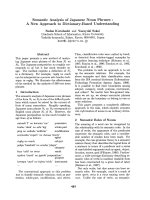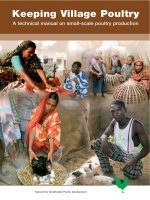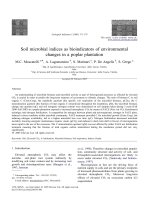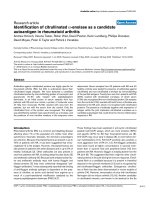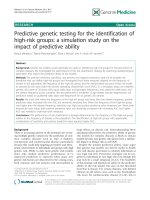Problems identification of DFI Village Jakhani: A participatory approach
Bạn đang xem bản rút gọn của tài liệu. Xem và tải ngay bản đầy đủ của tài liệu tại đây (157.2 KB, 5 trang )
Int.J.Curr.Microbiol.App.Sci (2020) 9(5): 353-357
International Journal of Current Microbiology and Applied Sciences
ISSN: 2319-7706 Volume 9 Number 5 (2020)
Journal homepage:
Original Research Article
/>
Problems Identification of DFI Village Jakhani: A Participatory Approach
Diksha Patel1, Shyam Singh2*, S. C. Singh1 and Manjul Pandey1
Krishi Vigyan Kendra, Banda, Universiy of Agriculture and Technology,
Banda-210001 (U. P.), India
*Corresponding author
ABSTRACT
Keywords
DFI, Focus group
discussion,
Participatory Rural
Appraisal, Problem
identification,
FPO
Article Info
Accepted:
05 April 2020
Available Online:
10 May 2020
The present study was undertaken at Krishi Vigyan Kendra, Banda, Uttar Pradesh where Jakhani
village has been selected for doubling farmers income by 2022. A total of 50 respondents were
selected randomly who were engaged in agriculture and allied activities. Data were collected through
focus group discussion, Participatory Rural Appraisal and a semi-structured interview schedule. The
problem identification technique was used to identify and prioritize the problems related to
agriculture and allied sectors in the village. The result of study revealed that nearly half of the
respondents (46.00%) were belongs to old aged category. Majority of respondents (88.00%) were
male, had high experience category (66.00%) and more than half of respondents (54.00%) were
having low level of annual income category. The result of problem identification technique revealed
that crop losses due to Anna pratha, getting less price for their produce (Pusa basmati-1121) and
poor yield of major crops (Rice and wheat) were the most prioritized problems of farmers of Jakhani
village with RBQ value 94.59, 90.41 and 71.66 respectively. The policy makers of state animal
husbandry department can develop plan for breed improvement and should also promote organic
farming by use of cow dung and urine to control the anna pratha. Farmers should be motivated to use
National Agriculture Market (e-NAM) and Farmer Producer Organisation (FPO) platform for
marketing of their farm produce to fetch better price for agriculture produce. Timely sowing, judicial
use of fertilizer and appropriate use of planting techniques should be adopted by farmers for getting
better yield of major crops.
threefold times while population multiplied
two and half fold. Due to this, India not only
becomes food self-sufficient but also a net
food exporting country.
Introduction
Agriculture is one of the most important pillar
of the Indian economy. The contribution of
agriculture and its allied sectors to India’s
GDP stood at 15.4% during 2018-19
(Government of India, 2019). More than half
of the country’s population is directly or
indirectly dependent on agriculture and allied
sectors for its subsistence. India’s food
production multiplied about more than
The past strategies do not explicitly recognize
the need to raise farmer’s income and did not
mention any direct measure to promote
farmers welfare. In many cases farmer’s
income did not grow much with increase in
output.
353
Int.J.Curr.Microbiol.App.Sci (2020) 9(5): 353-357
Farmer’s income remained low, which is
evident from incidence of poverty among
farm household. With all these past
experiences, there is need to focus on factors
which accelerate the income of farmers.
Therefore Government of India has initiated a
novel initiative for doubling farmer’s income
by 2022. The pathway for doubling of
farmers’ income includes several dimensions,
from production to post-harvest management.
The plan should include; bridging yield gap,
crop diversification, improvement in total
factor productivity and proper management of
irrigation (Birthal, et al., 2007; Chand, et al.,
2011) along with the provision of market and
institutional support for efficient post-harvest
management (Saxena, and Chand, 2017).
Therefore, strong measures will be needed to
harness all possible sources of growth in
farmer’s income within as well outside
agriculture sector. In the same line Krishi
Vigyan Kendra, Banda has adopted Jakhani
village for fulfilling the dream of Hon’ble
Prime minister of India, Shri Narendra Modiji
with the objective to double the farmer’s
income by 2022.
result eight main problems were listed down
and Rank based Quotient (RBQ) method was
used for ranking the most important and
severe problem.
RBQ= ∑fi (n+1-i) / M x n x100
Where,
fi
=
M
n
i
=
=
=
Number of respondents
reporting a particular problem
under ith rank
Number of respondents
Number of problems
Rank of problem
Results and Discussion
It is clearly evident from Table 1 that nearly
half of the respondents (46.00%) were
belongs to old aged category followed by
middle aged and young age category. Only
12.00 per cent of the respondents were
female, rest (88.00%) were the male. Nearly
equal percentage of respondents was found to
have formal education upto secondary
(24.00%) and higher secondary (30.00%).
Majority of respondent were (66.00%) were
having high category of experience followed
by medium level of experience (26.00%) and
low (8.00%) level of experience category.
Majority of respondents (74.00%) were living
in nuclear family whereas 26.00 per cent were
living in joint family. Majority of respondents
(54.00%) belongs to low category of annual
income.
Materials and Methods
The present study was undertaken at Krishi
Vigyan Kendra, Banda, Uttar Pradesh where
Jakhani village has been selected for doubling
farmers income. A total of 50 respondents
were selected randomly who were engaged in
agriculture and allied activities. Data were
collected through focus group discussion,
Participatory Rural Appraisal tools and a
semi-structured interview schedule.
Problem identification and prioritization
The problem identification technique was
used to identify and prioritize the problems
related to agriculture and allied sectors in
Jakhani village. For this purpose, around 50
farmers was asked to list their major problems
related to agriculture and allied sector then 30
farmers randomly were asked to rank based
on their severity of economic losses. As a
A list of problems have been listed and
prioritized according their RBQ value and
result were presented in Table 2 which
indicated that crop losses due to Anna pratha
was prioritized as most severe problem in
village with RBQ value (94.59). It was
reported during interactions with respondents
that farmers leave their cows and make them
354
Int.J.Curr.Microbiol.App.Sci (2020) 9(5): 353-357
stray animals as they were less productive.
Hence breed improvement programmes
should be implemented and farmers should
motivate to use cow dung and urine for
organic farming.
especially for Basmati rice and mini rice mill
also can be open for basmati rice that can play
good role for doubling farmers income.
Moreover farmers should also motivate to use
National Agriculture Market (e-NAM) and
Farmer Producer Organisation (FPO)
platform for marketing of their farm produce
to fetch better price.
Second most prioritized problems was getting
less price for their produce (Pusa Basmati1121) with RBQ value (90.41). It was found
that nearly 95.00% of farmers of village were
growing Pusa Basmati-1121 rice in Kharif
season but they were not getting fair price for
their produce. Farmers were hardly getting
Rs. 2800 to 3000 per Qt. It was suggested that
marketing structure should be opened
The finding was in line with findings of
Kumar et al., (2016) who reported that poor
access to market was the important problem
faced by the farmers in adoption of mitigation
and adaptation of climate change practices in
agriculture in Madhya Pradesh.
Table.1 Socio-economic profile of respondents (n=50)
S. no.
1
Variables
Age
2
Gender
3
Education
4
Experience
5
Family size
6
Family type
7
Annual income
Categories
Young (upto 35 Years)
Middle aged (36-50 years)
Old aged (>50 Years)
Male
Female
Illiterate
Primary
Middle
Secondary
Higher Secondary
Graduate and above
Low (< 5 years)
Medium (5-10 years)
High (>10 years)
Low (<5)
Medium (5-8)
High (>8)
Nuclear
Joint
Low (< Rs. 50,000)
Medium (Rs. 50,000-Rs.
1,00,000)
High (>Rs. 1,00,000)
355
Frequency
11
16
23
44
6
6
8
11
12
15
8
4
13
33
11
23
16
37
13
27
14
Percentage
22.00
32.00
46.00
88.00
12.00
12.00
16.00
22.00
24.00
30.00
16.00
8.00
26.00
66.00
22.00
46.00
32.00
74.00
26.00
54.00
28.00
9
18.00
Int.J.Curr.Microbiol.App.Sci (2020) 9(5): 353-357
Table.2 Problems identified in Jakhani village based on RBQ value (n=30)
Problem
RBQ Value
Rank
Crop losses due to Anna pratha
Getting less price for their produce (Pusa basmati-1121)
94.59
90.41
I
II
Poor yield of major crops (Rice and wsheat)
71.66
III
Disease infestation in dairy animals
53.34
V
Limited availability of agricultural inputs
Unawareness about the alternate source of income
36.25
23.75
VI
VII
Low milk yield of dairy animals
Migration of farmers from agriculture
69.99
21.67
IV
VIII
Third most important problems was poor
yield of major crops. The area has rice- wheat
cropping system and the yield of major crops
was found less as the farmers were less aware
of scientific package of practices of major
crop. Late sowing of crops, less use of
fertilizer, less availability of irrigation
facilities, terminal heat in wheat might be the
important causes of poor yield of major crops.
agricultural credit society. Unawareness about
the alternate source of income and migration
of farmers from agriculture were also the
important problems faced by the farmers of
Jakhani village.
The study concluded that, crop losses due to
Anna pratha, getting less price for their
produce (Pusa Basmati-1121) and poor yield
of major crops (Rice and wheat) were the
most prioritized problems of farmers,
therefore the policy makers of state animal
husbandry department can prepare plan for
breed improvement and also promote organic
farming by use of cow dung and urine.
The fourth most prioritized problems was low
milk yield of dairy animals with RBQ value
(69.99) it was reported that most of the
respondents were having non-descript cows
which were having less milk productivity
which was reported 0.5-1 litres of milk/day.
Farmers should be motivated to use National
Agriculture Market (e-NAM) and Farmer
Producer Organisation (FPO) platform for
marketing of their farm produce to fetch
better price. Timely sowing, judicial use of
fertilizer and appropriate use of planting and
agro techniques should be used for getting
better yield of major crops.
The disease infestation among dairy animals
was fifth prioritized problems of farmers of
Jakhani village. As it was reported that
animals were severely affected by Foot and
mouth disease and Haemorrhagic septicaemia.
Therefore mass vaccination programme
should be carried out by the department of
Animal Husbandry. Limited availability of
agricultural inputs was the sixth most
prioritized problems of respondents as it was
reported that various agricultural inputs which
includes seeds, fertilizers etc. were less
available to the farmers at primary
Acknowledgement
The authors acknowledged Directorate of
Extension, BUAT, Banda and Director ICARATARI, Kanpur for providing facilities and
guidance to carry out the work.
356
Int.J.Curr.Microbiol.App.Sci (2020) 9(5): 353-357
Information Bureau, Ministry of
Finance, Government of India.
Kumar, M.P.; Singh, R.J.; Pandey, D.K.;
Singh, R.; Jadav, N.B. and Rajput, R.P.
(2016). Problems faced by the farmers
in adoption of mitigation and adaptation
of climate change practices in
agriculture. International Journal of
Agriculture Sciences, 8(56): 3086-3088.
Saxena, R. and Chand, R. (2017).
Understanding the Recurring Onion
Price
Crisis:
Revelations
from
Production-Trade-Price
Linkages.
Policy
Paper
(Forthcoming).
Agricultural Economics and Policy
Research (NIAP), New Delhi
References
Birthal, P.S.; Joshi, P.K.; Roy, D. and Thorat,
A. (2007). Diversification in Indian
Agriculture towards High Value Crops:
The Role of Smallholders. IFPRI
Discussion Paper 00727, International
Food Policy Research Institute,
Washington, D.C.
Chand, R.; Kumar, P. and Kumar, S. (2011).
Total
Factor
Productivity
and
Contribution of Research Investment to
Agricultural Growth in India. Policy
Paper 25. National Centre for
Agricultural Economics and Policy
Research, New Delhi.
Government
of
India.
(2019).Press
How to cite this article:
Diksha Patel, Shyam Singh, S. C. Singh and Manjul Pandey. 2020. Problems Identification of
DFI Village Jakhani: A Participatory Approach. Int.J.Curr.Microbiol.App.Sci. 9(05): 353-357.
doi: />
357

